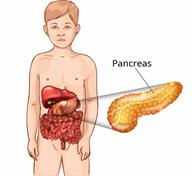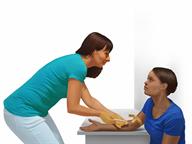Type 2 Diabetes Mellitus, Diagnosis, Pediatric

Type 2 diabetes (
type 2 diabetes mellitus) is a long-term, or chronic, disease. In type 2 diabetes, one or both of these problems may be present:
Normally, insulin allows blood sugar (glucose) to enter cells in the body. The cells use glucose for energy. Insulin resistance or lack of insulin causes excess glucose to build up in the blood instead of going into cells. This is how high blood glucose (hyperglycemia) develops.
What are the causes?
The exact cause of this condition is not known.
What increases the risk?
The following factors may make your child more likely to develop this condition:
Having a family member with type 2 diabetes.
Being overweight or obese.
Having an inactive (sedentary) lifestyle.
Having been unusually small before birth (intrauterine growth restriction).
Having been born to a mother who had a temporary form of diabetes during pregnancy (gestational diabetes).
Having been diagnosed with insulin resistance.
What are the signs or symptoms?
In the early stage of this condition, your child may not have symptoms. Symptoms develop slowly and may include:
Increased thirst or hunger.
Frequent urination or increased urination during the night. This may be a cause of bedwetting.
Unexplained weight loss.
Irritability or behavior changes.
Vision changes, such as blurry vision.
Dark patches on the skin.
Less common symptoms may include:
How is this diagnosed?

Type 2 diabetes is diagnosed based on your child's symptoms and medical history, a physical exam, and his or her blood glucose level. Your child's blood glucose may be checked with one or more of the following blood tests:
A fasting blood glucose (FBG) test. Your child will not be allowed to eat (he or she will fast) for 8 hours or longer before a blood sample is taken.
A random blood glucose test. This test checks blood glucose at any time of day regardless of when your child ate.
An A1C (hemoglobin A1C) blood test. This test provides information about blood glucose levels over the previous 2–3 months.
- An oral glucose tolerance test (OGTT). This test measures your child's blood glucose at two times:
Your child may be diagnosed with type 2 diabetes if his or her:
FBG level is 126 mg/dL (7 mmol/L) or higher.
Random blood glucose level is 200 mg/dL (11.1 mmol/L) or higher.
A1C level is 6.5% or higher.
OGTT result is higher than 200 mg/dL (11.1 mmol/L).
These blood tests may be repeated to confirm your child's diagnosis.
How is this treated?
Your child's treatment may be managed by a specialist called a pediatric endocrinologist. Follow instructions from your child's health care provider, which may include:
- Encouraging your child to make dietary and lifestyle changes. This may include having your child:
Follow a personalized nutrition plan that is developed by a registered dietitian.
Exercise regularly. Exercise can lower your child's blood glucose. It is especially important to check blood glucose before and after exercise. Your child may need to eat a snack before exercising to help prevent low blood glucose.
Checking your child's blood glucose as often as told.
Giving diabetes medicines or insulin daily. This helps to keep your child's blood glucose levels in the healthy range.
Giving medicines to help prevent complications from diabetes.
Making a written care plan (504 plan) for managing your child's diabetes at school.
Your child's health care provider will set personalized treatment goals based on your child's age and any other medical conditions he or she has.
Follow these instructions at home:
Questions to ask your child's health care provider
Consider asking the following questions:
Should my child and I meet with a certified diabetes care and education specialist?
What equipment will I need to manage my child's diabetes at home?
What diabetes medicines does my child need, and when should I give them?
How often do I need to check my child's blood glucose?
Where can I find a support group for children with diabetes?
What number can I call if I have questions?
When is my child's next appointment?
General instructions
For help and guidance and for more information about diabetes, please visit:
Contact a health care provider if:
-
Your child has a blood glucose level that is out of his or her healthy range. Your child's health care provider will give you guidelines about when you should contact a health care provider in these cases.
-
Your child develops a serious illness.
-
Your child has been sick or has had a fever for 2 days or longer, and he or she is not getting better.
-
Your child cannot eat or drink.
-
Your child has nausea or vomiting.
-
Your child has diarrhea.
-
Your child as severe hypoglycemia. This means having a blood glucose level that is lower than 54 mg/dL (3 mmol/L).
-
Your child becomes confused or has trouble thinking clearly.
-
Your child has difficulty breathing.
-
Your child has moderate or large ketone levels in his or her urine.
These symptoms may represent a serious problem that is an emergency. Do not wait to see if the symptoms will go away. Get medical help right away. Call your local emergency services (911 in the U.S.). Do not drive yourself to the hospital.
Summary
-
Type 2 diabetes (type 2 diabetes mellitus) is a long-term, or chronic, disease. In type 2 diabetes, the pancreas does not make enough of a hormone called insulin, or cells in the body do not respond properly to insulin that the body makes.
-
This condition is treated by encouraging your child to make dietary and lifestyle changes and giving diabetes medicines or insulin.
-
Your child's health care provider will set personalized treatment goals for your child based on age and any other medical conditions your child has.
-
Keep all follow-up visits. This is important.
This information is not intended to replace advice given to you by your health care provider. Make sure you discuss any questions you have with your health care provider.
 Type 2 diabetes (type 2 diabetes mellitus) is a long-term, or chronic, disease. In type 2 diabetes, one or both of these problems may be present:
Type 2 diabetes (type 2 diabetes mellitus) is a long-term, or chronic, disease. In type 2 diabetes, one or both of these problems may be present: Type 2 diabetes is diagnosed based on your child's symptoms and medical history, a physical exam, and his or her blood glucose level. Your child's blood glucose may be checked with one or more of the following blood tests:
Type 2 diabetes is diagnosed based on your child's symptoms and medical history, a physical exam, and his or her blood glucose level. Your child's blood glucose may be checked with one or more of the following blood tests: